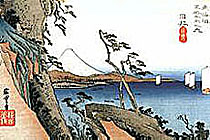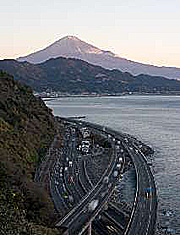The fishing village of Yui, which lies on Suruga Bay just southwest of Mt. Fuji, is best known as the sakura-ebi capital of Japan. These tiny pink "cherry-blossom" shrimp make a very tasty tempura dish, and Sakura-Ebi Street is lined with restaurants offering cuisine featuring the little crustaceans. Today the town seems literally bypassed by progress; the fishing harbor is sandwiched between the Shinkansen bullet train tracks and the Tomei Expressway. But Yui was once one of the 53 post towns along the great Tokaido highway running between Edo (old Tokyo) and Kyoto.
A twenty-minute walk from the Yui train station down Sakura-Ebi Street (which is indeed the original Tokaido, with some nice old wooden structures still standing here and there) will take you to the Tokaido Hiroshige Art Museum. This is the only museum in Japan devoted solely to the works of Utagawa (a.k.a. Ando) Hiroshige (1797-1858), the ukiyoe artist whose most famous series of woodblock prints is of the aforementioned 53 stations. A trip to Yui (about two hours by Shinkansen and local train from Tokyo) is recommended not only to ukiyoe buffs but to anyone interested in the history surrounding feudal Japan's legendary highway.
Though the Hoeido edition of the "53 Stations," so well known in the West, is the one that put Hiroshige on the map (so to speak), I didn't realize till I went to Yui that he produced a dozen other series on the same theme (not to mention other epics like the "69 Stations of the Kiso Road" and the "100 Views of Edo").
The museum houses some 1,200 Hiroshige prints, which it displays in rotation, but it always puts up the Hoeido series once a year (September 11 to October 10 this year). Another treat is an entire room offering a step-by-step description of the ukiyoe printing process. Though the captions are in Japanese, the exhibit is quite self-explanatory; among the fascinating displays is one of the pigments Hiroshige used, which included indigo, oyster shell, charcoal, mica, iron oxide, sulfur and arsenic.
But why does this remarkable museum happen to be in Yui? The town's identity as one of the 53 stations aside, there is no evidence that Hiroshige had much of anything to do with the place. What Yui does boast, however, is one of the most beautiful and arduous sections of the old Tokaido road: the notorious Satta Pass, by which travelers were forced to negotiate precipitous cliffs that plunge straight into the sea. Even today the cliffs pose an obstacle to transportation: the bullet train tunnels right under them, but the expressway had to be built on stilts just offshore.
Hiroshige's choice of a view for Yui is, appropriately, from the Satta Pass; in the Hoeido print a couple of tiny figures cling to the narrow clifftop path and are rewarded by a glorious panorama of Mt. Fuji towering over Suruga Bay. The view is just as spectacular today (you can reach the top of the pass in an hour's hike from the station), even if the shoreline below is now obscured by a tangle of highways and train tracks. Be sure to fortify yourself with a bowl of sakura-ebi tempura on rice before setting out.
 |
 |
 |
 |
|
|
|
left: Yui, by Utagawa Hiroshige (from the Hoeido edition of "53 Stations of the Tokaido")
right: The same view from Satta Pass today
|